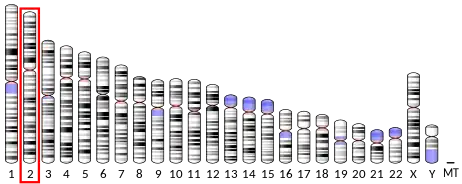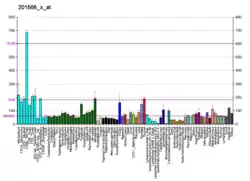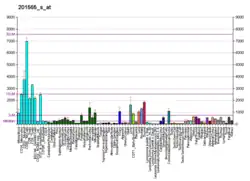DNA-binding protein inhibitor ID-2 is a protein that in humans is encoded by the ID2 gene.[5]
Function
The protein encoded by this gene belongs to the inhibitor of DNA binding (ID) family, members of which are transcriptional regulators that contain a helix-loop-helix (HLH) domain but not a basic domain. Members of the ID family inhibit the functions of basic helix-loop-helix transcription factors in a dominant-negative manner by suppressing their heterodimerization partners through the HLH domains. This protein may play a role in negatively regulating cell differentiation. A pseudogene has been identified for this gene.[6] A research published by "Nature" in 01/2016, authored by Italian researchers Antonio Iavarone and Anna Lasorella, from Columbia University, states that ID2 protein has a relevant role in the development and resistance to therapies of glioblastoma, the most aggressive of brain cancers.[7]
Interactions
See also
References
- 1 2 3 GRCh38: Ensembl release 89: ENSG00000115738 - Ensembl, May 2017
- 1 2 3 GRCm38: Ensembl release 89: ENSMUSG00000020644 - Ensembl, May 2017
- ↑ "Human PubMed Reference:". National Center for Biotechnology Information, U.S. National Library of Medicine.
- ↑ "Mouse PubMed Reference:". National Center for Biotechnology Information, U.S. National Library of Medicine.
- ↑ Hara E, Yamaguchi T, Nojima H, Ide T, Campisi J, Okayama H, Oda K (Feb 1994). "Id-related genes encoding helix-loop-helix proteins are required for G1 progression and are repressed in senescent human fibroblasts". J Biol Chem. 269 (3): 2139–45. doi:10.1016/S0021-9258(17)42146-6. PMID 8294468.
- ↑ "Entrez Gene: ID2 inhibitor of DNA binding 2, dominant negative helix-loop-helix protein".
- ↑ Lee, Sang Bae; Frattini, Veronique; Bansal, Mukesh; Castano, Angelica M.; Sherman, Dan; Hutchinson, Keino; Bruce, Jeffrey N.; Califano, Andrea; Liu, Guangchao; Cardozo, Timothy; Iavarone, Antonio; Lasorella, Anna (2016). "An ID2-dependent mechanism for VHL inactivation in cancer". Nature. 529 (7585): 172–177. Bibcode:2016Natur.529..172L. doi:10.1038/nature16475. PMC 5384647. PMID 26735018.
- ↑ Langlands K, Yin X, Anand G, Prochownik EV (Aug 1997). "Differential interactions of Id proteins with basic-helix-loop-helix transcription factors". J. Biol. Chem. 272 (32): 19785–93. doi:10.1074/jbc.272.32.19785. PMID 9242638.
- ↑ Law SF, Zhang YZ, Fashena SJ, Toby G, Estojak J, Golemis EA (Oct 1999). "Dimerization of the docking/adaptor protein HEF1 via a carboxy-terminal helix-loop-helix domain". Exp. Cell Res. 252 (1): 224–35. doi:10.1006/excr.1999.4609. PMID 10502414.
Further reading
- Biggs J, Murphy EV, Israel MA (1992). "A human Id-like helix-loop-helix protein expressed during early development". Proc. Natl. Acad. Sci. U.S.A. 89 (4): 1512–6. Bibcode:1992PNAS...89.1512B. doi:10.1073/pnas.89.4.1512. PMC 48481. PMID 1741406.
- Iavarone A, Garg P, Lasorella A, Hsu J, Israel MA (1994). "The helix-loop-helix protein Id-2 enhances cell proliferation and binds to the retinoblastoma protein". Genes Dev. 8 (11): 1270–84. doi:10.1101/gad.8.11.1270. PMID 7926730.
- Maruyama K, Sugano S (1994). "Oligo-capping: a simple method to replace the cap structure of eukaryotic mRNAs with oligoribonucleotides". Gene. 138 (1–2): 171–4. doi:10.1016/0378-1119(94)90802-8. PMID 8125298.
- Kurabayashi M, Jeyaseelan R, Kedes L (1993). "Two distinct cDNA sequences encoding the human helix-loop-helix protein Id2". Gene. 133 (2): 305–6. doi:10.1016/0378-1119(93)90658-P. PMID 8224921.
- Mathew S, Chen W, Murty VV, Benezra R, Chaganti RS (1996). "Chromosomal assignment of human ID1 and ID2 genes". Genomics. 30 (2): 385–7. doi:10.1006/geno.1995.0037. PMID 8586447.
- Lasorella A, Iavarone A, Israel MA (1996). "Id2 specifically alters regulation of the cell cycle by tumor suppressor proteins". Mol. Cell. Biol. 16 (6): 2570–8. doi:10.1128/MCB.16.6.2570. PMC 231247. PMID 8649364.
- Hara E, Hall M, Peters G (1997). "Cdk2-dependent phosphorylation of Id2 modulates activity of E2A-related transcription factors". EMBO J. 16 (2): 332–42. doi:10.1093/emboj/16.2.332. PMC 1169639. PMID 9029153.
- Langlands K, Yin X, Anand G, Prochownik EV (1997). "Differential interactions of Id proteins with basic-helix-loop-helix transcription factors". J. Biol. Chem. 272 (32): 19785–93. doi:10.1074/jbc.272.32.19785. PMID 9242638.
- Suzuki Y, Yoshitomo-Nakagawa K, Maruyama K, Suyama A, Sugano S (1997). "Construction and characterization of a full length-enriched and a 5'-end-enriched cDNA library". Gene. 200 (1–2): 149–56. doi:10.1016/S0378-1119(97)00411-3. PMID 9373149.
- Yates PR, Atherton GT, Deed RW, Norton JD, Sharrocks AD (1999). "Id helix-loop-helix proteins inhibit nucleoprotein complex formation by the TCF ETS-domain transcription factors". EMBO J. 18 (4): 968–76. doi:10.1093/emboj/18.4.968. PMC 1171189. PMID 10022839.
- Yokota Y, Mansouri A, Mori S, Sugawara S, Adachi S, Nishikawa S, Gruss P (1999). "Development of peripheral lymphoid organs and natural killer cells depends on the helix-loop-helix inhibitor Id2". Nature. 397 (6721): 702–6. Bibcode:1999Natur.397..702Y. doi:10.1038/17812. PMID 10067894. S2CID 4428856.
- Law SF, Zhang YZ, Fashena SJ, Toby G, Estojak J, Golemis EA (1999). "Dimerization of the docking/adaptor protein HEF1 via a carboxy-terminal helix-loop-helix domain". Exp. Cell Res. 252 (1): 224–35. doi:10.1006/excr.1999.4609. PMID 10502414.
- Moldes M, Boizard M, Liepvre XL, Fève B, Dugail I, Pairault J (2000). "Functional antagonism between inhibitor of DNA binding (Id) and adipocyte determination and differentiation factor 1/sterol regulatory element-binding protein-1c (ADD1/SREBP-1c) trans-factors for the regulation of fatty acid synthase promoter in adipocytes". Biochem. J. 344 (3): 873–80. doi:10.1042/0264-6021:3440873. PMC 1220711. PMID 10585876.
- Liu J, Shi W, Warburton D (2000). "A cysteine residue in the helix-loop-helix domain of Id2 is critical for homodimerization and function". Biochem. Biophys. Res. Commun. 273 (3): 1042–7. doi:10.1006/bbrc.2000.3055. PMID 10891368.
- Lasorella A, Noseda M, Beyna M, Yokota Y, Iavarone A (2000). "Id2 is a retinoblastoma protein target and mediates signalling by Myc oncoproteins". Nature. 407 (6804): 592–8. Bibcode:2000Natur.407..592L. doi:10.1038/35036504. PMID 11034201. S2CID 4335368.
- Roberts EC, Deed RW, Inoue T, Norton JD, Sharrocks AD (2001). "Id Helix-Loop-Helix Proteins Antagonize Pax Transcription Factor Activity by Inhibiting DNA Binding". Mol. Cell. Biol. 21 (2): 524–33. doi:10.1128/MCB.21.2.524-533.2001. PMC 86614. PMID 11134340.
- Wang S, Sdrulla A, Johnson JE, Yokota Y, Barres BA (2001). "A role for the helix-loop-helix protein Id2 in the control of oligodendrocyte development". Neuron. 29 (3): 603–14. doi:10.1016/S0896-6273(01)00237-9. PMID 11301021. S2CID 7978661.
- Wong J, Funes-Duran M, Ahlberg J, Round J, O'Connell R, Miller R, Chen E, Richmond PA, Vierra CA (2001). "Characterization of a basic helix-loop-helix protein, ABF-1: nuclear localization, transcriptional properties, and interaction with Id-2". DNA Cell Biol. 20 (8): 465–71. doi:10.1089/104454901316976091. PMID 11560778.
- Suzuki H, Fukunishi Y, Kagawa I, Saito R, Oda H, Endo T, Kondo S, Bono H, Okazaki Y, Hayashizaki Y (2001). "Protein–Protein Interaction Panel Using Mouse Full-Length cDNAs". Genome Res. 11 (10): 1758–65. doi:10.1101/gr.180101. PMC 311163. PMID 11591653.
External links
- ID2+protein,+human at the U.S. National Library of Medicine Medical Subject Headings (MeSH)
- Overview of all the structural information available in the PDB for UniProt: Q02363 (DNA-binding protein inhibitor ID-2) at the PDBe-KB.
This article incorporates text from the United States National Library of Medicine, which is in the public domain.





